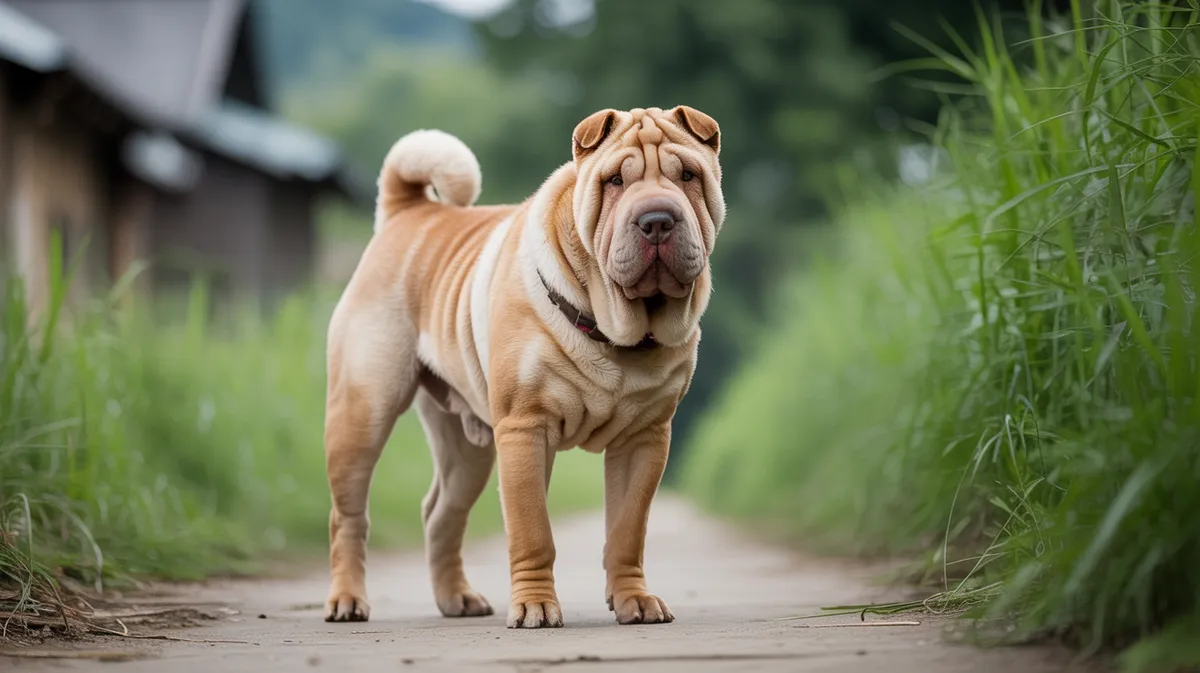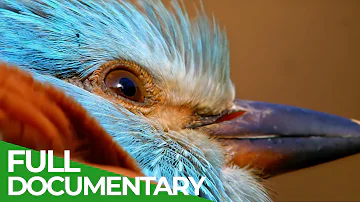
Chinese Shar Pei
Canis lupus familiaris

Meet the Chinese Shar Pei
The Chinese Shar Pei is a medium-sized dog breed renowned for its deeply wrinkled skin and distinctive 'hippopotamus' muzzle. Originally developed in southern China, this ancient breed was historically used for hunting, guarding, and herding livestock. Shar Peis are known for their loyal and independent temperament, as well as their unique blue-black tongues. The breed’s short, bristly coat and loose skin were once advantageous in dog fighting, making it difficult for opponents to grasp them. Today, Shar Peis are cherished as companion animals for their intelligence, calm demeanor, and alertness.
Classification
Mammal
Habitat
Domestic environments; originally rural and village settings in southern China
Diet
Omnivore
Lifespan
8-12 years
Conservation
Least Concern
Weight
16–29 kg (35–64 lbs)
📖Fascinating Facts
Wrinkled Wonder
Shar Pei puppies are especially wrinkled, but as they mature, many of the wrinkles smooth out, remaining mostly on the head, neck, and shoulders.
Blue-Black Tongue
Both the Shar Pei and the Chow Chow possess an unusual blue-black tongue, a rare trait in the canine world.
Ancient Heritage
The breed’s origins date back over 2,000 years in China, making the Shar Pei one of the oldest dog breeds still in existence.
📋Detailed Description
The Chinese Shar Pei is a medium-sized, compact dog breed, typically weighing between 16 and 29 kg (35–64 lbs) and standing 44–51 cm (17–20 in) at the withers. The breed is instantly recognizable by its deeply wrinkled skin, particularly pronounced in puppies, and its broad, 'hippopotamus-like' muzzle. The Shar Pei's coat is short, harsh, and bristly, coming in solid colors except white, and is classified into three types: horse coat (very short and rough), brush coat (slightly longer and softer), and the rare bear coat (longer, not breed standard). Anatomically, the breed features small, triangular ears, a high-set tail that curls over the back, and a blue-black tongue—a trait shared only with the Chow Chow among domestic dogs. Shar Peis possess a strong, muscular build, with loose skin that historically provided protection in fights and when working with livestock. Behaviorally, they are known for their calm, independent, and loyal temperament, often forming strong bonds with their families while remaining reserved with strangers. Social structure in the home is typically centered around their human companions, and they may show territorial tendencies. Reproduction is typical of domestic dogs, with litters averaging 4–6 puppies. Notably, the breed is prone to certain hereditary health issues, such as entropion (inward rolling of the eyelids) and Shar Pei fever, a periodic fever syndrome. The Shar Pei's unique adaptations, including its wrinkled skin and bristly coat, are believed to have evolved in response to its original roles as a guardian, hunter, and fighter in rural Chinese villages.
💡 Did you know?
The Shar Pei's deep wrinkles were bred to help defend them against predators and other dogs, as the loose skin made it difficult to grab and allowed the dog to twist and fight back even when held.
🔬Research & Sources
Wikipedia Summary
The Shar Pei is a dog breed from southern China. Traditionally kept as a property guardian, the shar pei was driven to the brink of extinction in the 20th century. The breed is known in the West for its deep wrinkles, while a traditional less wrinkled form is maintained in Hong Kong.
Last Modified: 5/1/2025
🎭Behavior & Social Structure
Shar Peis are generally quiet, alert, and dignified dogs, displaying a strong sense of loyalty and protectiveness toward their families. They are known for their independence and can be aloof with strangers, making them effective watchdogs. Early socialization is crucial to prevent excessive wariness or aggression. Historically, Shar Peis were used for hunting wild boar and guarding property, which is reflected in their keen senses and territorial instincts. They are not typically aggressive without provocation but may be assertive with other dogs, especially of the same sex. Feeding behavior is typical of domestic dogs; they are omnivorous and thrive on a balanced diet of high-quality commercial or home-prepared food. Daily routines include moderate exercise, such as walks and play sessions, but they are not as high-energy as some working breeds. Shar Peis are intelligent and can be trained, though their independent streak may require patient, consistent handling.
👶Reproduction & Life Cycle
The Chinese Shar Pei reaches sexual maturity between 6 and 12 months of age. Females generally come into estrus twice a year, with each heat cycle lasting approximately 2–3 weeks. Mating is typically managed by breeders to avoid hereditary health issues. The gestation period averages 63 days, after which litters of 4–6 puppies are born. Puppies are notable for their extreme wrinkling, which diminishes as they mature. Parental care is typical of domestic dogs, with the mother providing warmth, cleaning, and nursing for the first few weeks. Breeders often monitor for congenital issues such as entropion or skin infections. Responsible breeding practices emphasize genetic health and temperament.
🛡️Adaptations & Survival
The Shar Pei's most distinctive adaptation is its loose, wrinkled skin, which historically protected vital organs during fights or when working with livestock, as opponents would often only grasp skin rather than muscle. The bristly, harsh coat (horse coat) is thought to deter parasites and provide some protection from the elements. The blue-black tongue, a rare trait among dogs, may have originally served as a visual deterrent or marker of breed purity. Behaviorally, their reserved and independent nature is well-suited to guarding and protecting property. Their strong territorial instincts and acute senses make them effective watchdogs, while their moderate energy levels and adaptability allow them to thrive in both rural and urban environments.
🎨Cultural Significance
The Shar Pei is deeply rooted in Chinese culture, where it was traditionally valued as a guardian, hunter, and companion. Its name means 'sand skin' in reference to its rough coat. The breed has appeared in Chinese art and folklore, symbolizing loyalty, protection, and good fortune. In the 1970s, the Shar Pei was recognized by the Guinness Book of World Records as one of the world's rarest dog breeds, which contributed to its surge in popularity in the West. Today, the Shar Pei is regarded as a symbol of Chinese heritage and is celebrated in dog shows and cultural events worldwide.
🔬Recent Research & Discoveries
Recent scientific studies have focused on the genetic basis of the Shar Pei's unique skin and health disorders. A 2011 study identified a duplication in the HAS2 gene, responsible for excessive hyaluronic acid production, as the cause of the breed's characteristic wrinkling and predisposition to Shar Pei fever. Ongoing research aims to better understand and manage hereditary health issues, particularly periodic fever syndromes and amyloidosis. Veterinary research also addresses best practices for breeding, skin care, and management of entropion. The breed's genetic diversity is being monitored to prevent further health deterioration due to inbreeding.
🎥Wildlife Videos

ALL ABOUT CHINESE SHAR PEI ANCIENT AND AMAZING
Please support the Channel by checking out my affiliate links!!! Become a Dogumentary TV Channel member!!!
Dogumentary TV

Wild China - Fantastic Creatures of Yunnan | Free Documentary Nature
Wild China - Fantastic Creatures of Yunnan | Free Documentary Nature Watch 'A Wildlife Odyssey - Southeast Asia's Island ...
Free Documentary - Nature

China Wild | Episode 2: The Forests | Free Documentary Nature
China Wild - Episode 2: The Forests | Wildlife Documentary Watch 'China Wild - Episode 3' here: https://youtu.be/cZvJsCW7isE ...
Free Documentary - Nature

Wildest Indochina | Episode 5: China - The Secret Garden | Free Documentary Nature
Wildest Indochina - Episode 5: China - The Secret Garden | Wildlife Documentary Wach 'Wildest Indochina - Episode 1' here: ...
Free Documentary - Nature

Wild Asia - Fantastic Creatures of Tian Shan | Free Documentary Nature
Kingdom of the Bears: Masters of Wilderness | Free Documentary Nature Kingdom of the Bears: Asia's Brown Bear Mountains ...
Free Documentary - Nature

A Wildlife Odyssey - Southeast Asia's Island Paradise | Part 1 | Free Documentary Nature
A Wildlife Odyssey - Southeast Asia's Island Paradies | Part 1: Born of Fire | Wildlife Documentary Watch 'A Wildlife Odyssey - Part ...
Free Documentary - Nature
🌍Habitat Information
The Chinese Shar Pei typically inhabits Domestic environments; originally rural and village settings in southern China environments. Chinese Shar Peis have adapted to their environments with specialized features and behaviors.
Primary Habitat:
Domestic environments; originally rural and village settings in southern China
More detailed habitat information will be available soon.
🛡️Conservation Status
The Chinese Shar Pei is currently classified as Least Concern. Conservation efforts are crucial for preserving this species for future generations.
Common Threats:
- 🏠Habitat loss and fragmentation
- 🌡️Climate change impacts
- 🎯Hunting and poaching
- 🏭Human-wildlife conflict
⚠️Threats & Conservation Challenges
The Shar Pei faced near extinction in the mid-20th century, particularly during the Communist era in China when dog ownership was discouraged. The breed survived due to the efforts of breeders in Hong Kong and later in the West. Today, the main challenges are genetic health issues resulting from a limited gene pool, including Shar Pei fever (familial Shar Pei fever), amyloidosis, entropion, and skin infections. Overbreeding for extreme wrinkling has exacerbated some of these problems. While the breed is not currently threatened with extinction, responsible breeding and genetic diversity remain ongoing concerns. Population numbers are stable in most countries, but health-related challenges persist.
🔬Scientific Classification
Scientific Name
Canis lupus familiaris
Classification Hierarchy
🔍 About Taxonomic Classification
Taxonomic classification is a hierarchical system used by scientists to classify and organize living organisms based on shared characteristics and evolutionary relationships.
The system moves from broad categories (Kingdom) to increasingly specific ones, with each animal's scientific name typically consisting of its Genus and species.
📝Community Notes
Share your observations and insights about the Chinese Shar Pei with our community of wildlife enthusiasts.
Join Our Community
Sign in to share your observations and connect with fellow wildlife enthusiasts.
Sign In to ContributeNo community notes yet
Be the first to share your observations about the Chinese Shar Pei!
Explore Chinese Shar Pei
Select a tab above to learn more about this amazing animal.
📸Photo Gallery
No photos available for this animal yet.
🌟Discover More Wildlife
Continue your journey of discovery with more fascinating animals from our database
